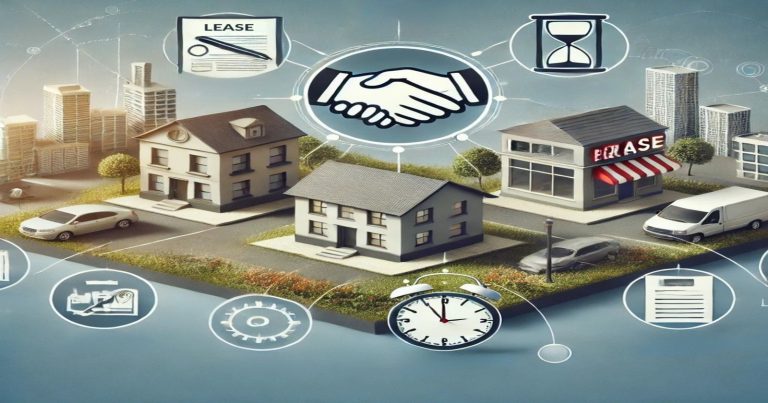A lease is a contractual arrangement where one, the lessor, conveys to another, the lessee, the privilege of using a property for a period of time in return for frequent payments. Leasing is frequently applied to properties like land, property, equipment, and vehicles. Leasing benefits businesses and people by accessing resources without outright acquisition. Leases are classified according to function and address different financial and operational requirements.
Leasing is flexible and easy on the finances, particularly for companies that require costly equipment but do not want to make huge initial investments. Some leases permit ownership transfer after the lease term, while others are purely rental contracts. Types of lease enable companies and individuals to make sound financial choices.
Types of Lease
The way leases are used changes across different industries and economies. This is due to the different kinds of leases available. Leases are sorted by who owns them, how the payments work, and the legal area they fall under. Here are the main types of leases explained:
1. Finance Lease
A finance lease, or a capital lease, enables the lessee to utilize an asset for the majority of its useful life. In a finance lease, the title still belongs to the lessor, but the risks and benefits of the asset are assumed by the lessee.
- The lessee makes regular rentals, amortizing the cost of the asset over time.
- The leasing duration tends to be lengthy, usually approaching the lifetime of the asset.
- The lessee can have the privilege to buy the asset upon termination of the lease term.
- Widespread for machinery, cars, and costly equipment.
2. Operating Lease
An operating lease is a temporary lease where the ownership of the asset remains with the lessor, and the lessee just pays to utilize it for a given period. The lessee does not have to bear the risks of the ownership, so it is appropriate for businesses that require flexibility without any long-term obligation.
- The lessee does not acquire ownership rights.
- The lease period is significantly shorter than the asset’s useful life.
- Prevalent for IT machinery, working offices, and vehicles.
- Appropriate for companies that upgrade hardware often.
3. Leveraged Lease
There are three participants in a leveraged lease: the lessee, the lessor, and a lender. The lessor provides funding for a portion of the asset cost, while the rest is funded by a financial institution.
- The lender acquires a security interest in the leased property.
- The lessee pays regular sums to finance.
- Prevalent in infrastructure financing ventures such as railway and aircraft finance.
4. Conveyance Lease
A conveyance lease is like a finance lease but involves a documented ownership transfer at the end of the lease term. The lease guarantees that the lessee gets full ownership of the asset as soon as they make the final payment. It is highly employed in real property and industrial machinery leasing, where companies can get significant assets without full payment immediately. The terms of the lease are intended to ensure a seamless transfer of ownership, thus making it a preferred choice for companies seeking long-term stability and control over assets.
- Transfers ownership automatically upon payment in full.
- Applied to real estate and industrial machinery.
- Guarantees long-term stability for lessees.
5. Sale & Leaseback
In a sale and leaseback deal, an owner sells an asset to a leasing company and then leases it back to use. It enables firms to capture the value of the asset and at the same time maintain its operational benefit. The lessee is not interrupted from utilizing the asset, yet the sale proceeds may be used in growing the business, settling debt, or otherwise. Such leasing is frequent in such business industries as manufacturing, aviation, and real estate, as corporations may require the use of capital while retaining availability of valuable assets.
- Aids companies to raise capital without sacrificing asset useability.
- Widespread among real estate and aviation industries.
- Provides liquidity while maintaining ongoing operational effectiveness.
6. Complete & Non Pay Out Lease
A full lease includes the cost of all expenses on an asset, such as insurance, repairs, and maintenance, so that the lessee does not incur extra expenses. A non pay out lease prohibits the lessee from acquiring ownership of the asset upon the elapse of the leasing period, i.e., the lessee has to give back the asset once the contract is over. It is such that the business organizations prefer it when they do not wish to enter into long-term commitments but desire uninterrupted use of an asset. It is well applied in fleet management, construction equipment leasing, and sectors that need recurrent upgrading of equipment.
- Ideal for companies seeking a hassle-free leasing experience.
- Applied in heavy machinery and fleet management industries.
7. Specialized Service Lease
These specific equipment or tools that you need is provided to you in a special service lease.Every detail of these leases is designed specifically for the location of your enterprise so that it all fits perfectly together as it ought to and enables the enterprise to function smoothly. The resulting design means all is set up just right for smooth operation. All the equipment or tools to be provided in this lease is designed specifically to fit in with the very particular demands of the business, thus making sure they can help the company’s operation run smoothly. For example, the leasing lessee has made an individually tailored package including added-value maintenance and update support services which is perfect for fields like construction, healthcare and information technology. Through a specialized service lease, businesses can bypass the financial burden of acquiring high-cost, industry-specific machinery and still be able to provide optimal performance as well as meet sector regulations.
- The lessee is charged for the asset and ancillary services.
- Utilized in construction, healthcare, and IT sectors.
- Assures that assets satisfy business-specific needs.
8. Net & Non Net Lease
In a net lease, the lessee must also pay additional expenses such as real estate taxes, maintenance and insurance. Structuring major costs this way gives lessees more control over their overall expenses, which in turn typically helps lower basic rents. In a non-net lease the rental fee includes these costs, which allows control over what portion of your fixed charges is unknown. Net leases are used in commercial property, with the customer enjoying flexibility in handling costs of doing business, whereas non-net leases suit firms that desire monthly fixed payments without other financial burdens.
- Applied in heavy equipment and real estate industries.
- Provides flexibility in cost control.
9. Sales Aid Lease
The intent of a sales aid lease is to allow a manufacturer or vendor to lease items to consumers rather than sell it to them. It does so in a manner of selecting customers that pay term by term instead of obviously providing a respective stream of revenues to the business. It is frequently utilized in sectors like electronics, automobiles, and machinery, where the consumer likes leasing because it is cheaper compared to outright purchase. Also, producers enjoy greater product flow and market coverage without demanding upfront full payments from consumers.
- Promotes customer retention with flexible leasing.
- Widespread in electronics, automotive, and machinery sectors.
10. Cross Border Lease
Cross-border lease, a tool for companies located in two different nations. Normally employed by multinational enterprises to manage properties in outside markets. Cross-border leases are prevalent in industries such as aviation, shipping and heavy industry which have to operate across multiple jurisdictions. Proper financial and legal planning is necessary for ensuring compliance with different regulations in different jurisdictions. msec enterprises to redefine production costs and tax strategies. Common in chemicals, airfreight and shipping.
11. Tax Oriented Lease
A tax-based lease is designed to offer tax advantages to the lessor and cost advantages to the lessee.But the lessee is liable to pay a higher rental charge. It may be capital-intensive industries such as manufacturing, transportation, and infrastructure where this kind of offer is most welcome summed up in one word -cheap. Companies will find this an attractive financial solution, because the lease lets them have their taxes and continue to use what they need of all those assets without any cost for capital expenditure.
- The lessor is entitled to depreciation benefits.
- Applied in asset-intensive sectors such as manufacturing.
12. Import Lease
An imported lease is one that a lessee makes when he imports the asset.The general idea is that a company is able to acquire costly equipment or machinery through leasing transactions. In this way they can escape bearing the full cost at once.It is particularly suited to firms that need high-tech equipment, or very sophisticated machinery which cannot be purchased from the local material market. Import leases allow companies to efficiently manage cash flow while having access to essential resources that enhance productivity and competitiveness.
- Facilitates companies to purchase overseas machinery without substantial initial expenses.
- Widely used in industrial and automotive industries.
13. International Lease
International leases deal with cross-border leases under international law system. For those companies operating in many a country, international leases mean possessing assets but not buying them outright. Such leasing, at the same time as meeting countless international norms and taxation structures, grants enterprises an instrument to obtain important equipment and facilities. It is widely applied in the logistics, shipping, and international manufacturing industries to ease international operations and asset management at minimal cost.
- Guarantees compliance with international trade laws.
- Applied in the logistics, shipping, and global manufacturing industries.
Relevance to ACCA Syllabus
The topic of types of lease forms part of the ACCA syllabus, especially under Financial Reporting (FR) and Strategic Business Reporting (SBR). ACCA candidates should be able to know how leases are accounted for under IFRS 16 – Leases, i.e., how they are recognized, measured, and their impact on financial statements. Leases are also an important subject for auditing, taxation, and financial management modules.
Types of Lease ACCA Questions
Q1: Which IFRS standard provides the accounting for leases, including their recognition, measurement, and disclosure?
A) IFRS 9
B) IFRS 15
C) IFRS 16
D) IFRS 13
Answer: C) IFRS 16
Q2: In accordance with IFRS 16 which type of lease does the lessee have to recognize a right-of-use asset and a lease liability for?
A) Finance Lease
B) Operating Lease
C) Sale and Leaseback
D) Short-Term Lease
Answer: A) Finance Lease
Q3: What is the distinguishing feature of a finance lease in IFRS 16?
A) The lessee accounts for an expense for the lease payments.
B) The lessee receives ownership at the end of the lease term.
C) The term of the lease is always shorter than one year.
D) The payments of the lease are variable and do not give rise to an obligation.
Answer: B) Ownership is transferred to the lessee at the end of the lease.
Q4: Which of the following is NOT a lease modification under IFRS 16?
A) Modifying the lease term
B) Introducing new leased assets
C) Modifying the ownership of the lessor
D) Modifying the payment structure
Answer C Modifying the ownership of the lessor
Relevance to US CMA Syllabus
Leasing decisions appear on CMA syllabi as part of Financial Reporting (Part 1) and Corporate Finance (Part 2). The candidates are supposed to grasp the accounting of lease under US GAAP (ASC 842) and lease classes and its impact on cost of capital, cash flows, and financial ratios during decision-making.
Types of Lease US CMA Questions
Q5: Under U.S. GAAP (ASC 842), which of the following is a key feature of an operating lease?
A) The lessee recognizes a right-of-use asset and lease liability.
B) The lease transfers ownership of the asset at the end of the lease.
C) The lease term is insignificant relative to the economic life of the asset.
D) The lease must always include a purchase option.
Answer: C) The lease term is insignificant relative to the economic life of the asset.
Q6: How does a lease impact the lessee’s financial statements under ASC 842?
A) Only finance leases affect the balance sheet.
B) Operating leases are recognized as liabilities but not as assets.
C) Both operating and finance leases require lessees to recognize assets and liabilities.
D) Lease expenses are only recognized in the cash flow statement.
Answer: C) Both operating and finance leases require lessees to recognize assets and liabilities.
Q7: Which financial metric is most affected when a company shifts from operating leases to finance leases?
A) Gross Profit Margin
B) Earnings Per Share (EPS)
C) Return on Assets (ROA)
D) Quick Ratio
Answer: C) Return on Assets (ROA)
Relevance to US CPA Syllabus
The Certified Public Accountant (CPA) exam addresses leases in great detail in the Financial Accounting and Reporting (FAR) section. Candidates should be aware of how to distinguish between finance and operating leases under ASC 842, how to understand lease disclosures, and how to examine the effect of lease liabilities on financial statements. This is also important for auditing and tax implications.
Types of Lease US CPA Questions
Q8: Under ASC 842 which of the following is a requirement for a lease to be classified as a finance lease?
A) The lease term covers less than 50% of the asset’s useful life.
B) The lease does not include a residual value guarantee.
C) The lease grants an option to purchase the asset at a bargain price.
D) The lease payments are variable based on asset usage.
Answer: C) The lease grants an option to purchase the asset at a bargain price.
Q9 How does a finance lease differ from an operating lease in a lessee’s financial statements under US GAAP?
A) Finance leases create depreciation and interest expenses, whereas operating leases result in a single lease expense.
B) Operating leases increase total liabilities, while finance leases do not.
C) Finance leases are treated as short-term liabilities.
D) Operating leases always include ownership transfer at the end of the lease.
Answer: A Finance leases create depreciation and interest expenses, whereas operating leases result in a single lease expense.
Q10: Which entity benefits the most from a sale and leaseback transaction?
A) Lessor only
B) Lessee only
C) Lessee and Lessor both
D) Only financial institutions
Answer: C) Lessee and Lessor both
Relevance to CFA Syllabus
As the curriculum reiterates, Leasing is one of the key topics in Financial Reporting and Analysis? The financial analyst, therefore, must decide what effect different lease arrangements have on a company’s fortune-or more accurately, its chance of making ends meet and mid- to long-term complementarity with other businesses. Leases carry with them implications for financial ratios, leverage, and investment choices. The subject may therefore be considered indispensable training for an analyst.
Types of Lease CFA Questions
Q11 Why do companies often choose operating leases instead of finance leases when looking at it from investors perspective?
A) Operating leases reduce reported debt and improve financial ratios.
B) Finance leases provide tax advantages.
C) Operating leases lead to higher interest costs.
D) Finance leases are always cheaper than operating leases.
Answer: A) Operating leases reduce reported debt and improve financial ratios.
Q12: How do leases impact financial leverage in corporate finance analysis?
A) Leases do not affect financial leverage.
B) Operating leases increase financial leverage.
C) Finance leases increase financial leverage by recognizing liabilities.
D) Lease classification does not impact a company’s credit rating.
Answer: C) Finance leases increase financial leverage by recognizing liabilities.
Q13: Which ratio is most commonly used to assess the impact of leases on financial statements?
A) Inventory Turnover
B) Debt-to-Equity Ratio
C) Price-to-Earnings Ratio
D) Dividend Yield
Answer: B) Debt-to-Equity Ratio


